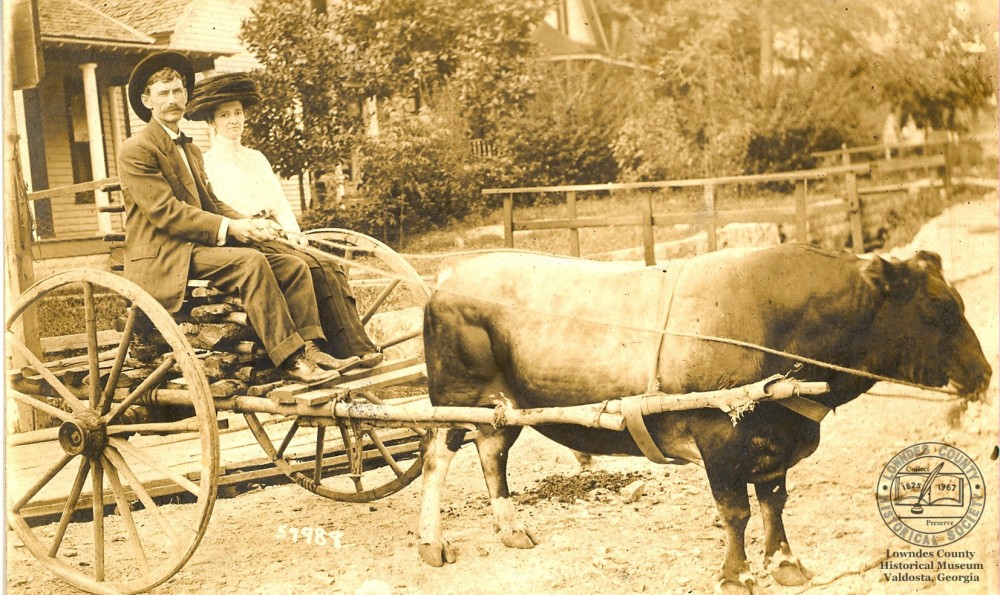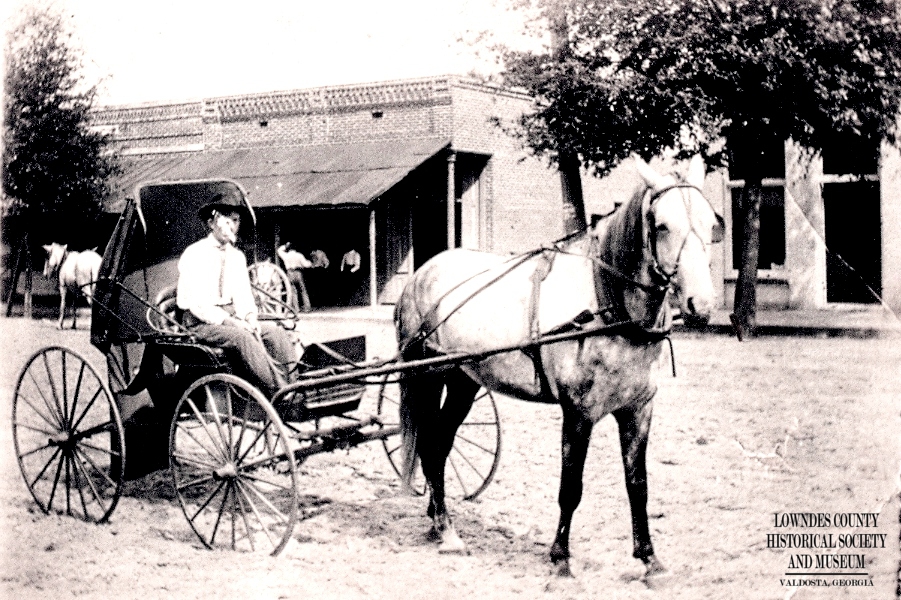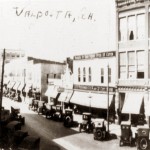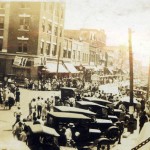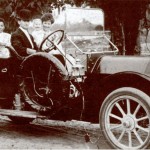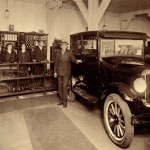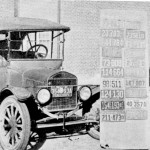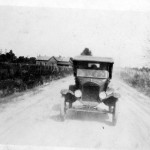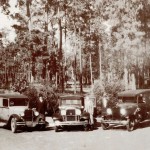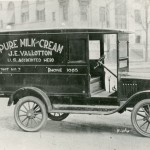The introduction of new motorized transportation drastically redefined the development of Valdosta and Lowndes County. Unlike trains, cars and trucks were far less restricted in the places they could reach. Early cars made for better access to rural parts of the county. Automobiles allowed towns like Valdosta to grow and spread out.
The Horse and Buggy
Before automobiles communities often formed along railroads, with trains being the fastest and most efficient way to travel. Towns like Valdosta, Hahira, Naylor, and Lake Park all developed where they are because of their proximity to rail lines. The only other means of getting around in Lowndes County early on was by dirt roads and on horse (or ox) and buggy. The following images illustrate transportation in our community before highways and cars.
Early Automobiles
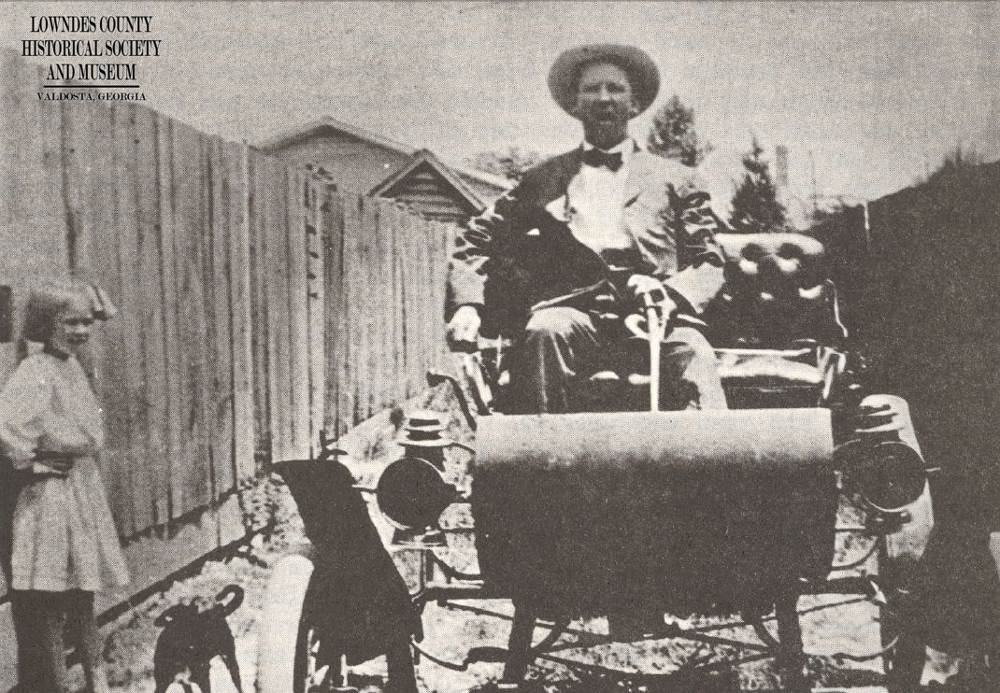
E. R. Barber in the first auto in Valdosta, an “Olds,” a breezy, open-air, runabout. The little girl is Sara McArthur. Mrs. E. D. King, Barber’s daughter, took the picture.
1903 brought Valdosta’s first paved street – brick on Hill Avenue. The coming of automobiles brought new regulations. In 1910 the speed limit was set at 8 miles per hour in the city limits and 12 mph outside. In 1911 these were amended to 10 and 15 mph. Another law was passed to prohibit repairing a car on the street.
By May 1907 Valdosta had its first automobile agency, H. K. Mclendon who sold the celebrated Reo runabouts. The number of local cars began to increase. The Reo was unsurpassed as a machine for sandy or rough roads, or on Valdosta’s few paved streets.
In April 1907, Mr. A. J. Strickland’s purchase of a new $3,000 automobile brought the number of autos to fifteen. In October, W.S. McRee and A. S. Pendleton, and Abial Winn were others who had recently purchased new machines. Mr. C.L. Jones drove his automobile to Nashville and returned to Valdosta in four hours, or less time than a wagon on a one way trip.
In January 1909, Mr. M. A. Briggs went to Tifton “to meet his new automobile.” Abial and Fleming Winn took a long run in a fine machine going to Tallahassee and Thomasville. They reported that the Brooks and Thomas County roads were in much better condition than in Lowndes.
More new autos arrived that January. Dr. J. C. Wilson and Col. C. L. Smith both purchased new machines. Col. C. L. Smith’s new car brought the total number of local autos to between twenty-eight and thirty.
Enter the cops! “Auto Driver Is Pulled.” Chief Dampier pulled an automobile driver for running his machine too fast on the streets. A newspaper article, while commending the officials for their action, warned all drivers to be careful of their autos and to help avoid accidents. Thirteen miles an hour was fast enough.
At the end of the year 1909, there must have been sixty to seventy autos driving around Valdosta. Soon the horse was only a farm animal. In the December 28, 1909 Times, Mr. John T. Roberts had two ads. One ad was for “buggies, wagons, harness, automobiles, and saddles.” Mr. Roberts’s other ad was for a brand new sports car, “Buick, Model 10, Toy Tonneau, Model 16.”
- Patterson Street in the early 1900s, lines with cars
- Patterson Street lined with cars during a parade through downtown Valdosta
- Dr. J.F. Mixson, Sr. and his family enjoying a ride in their Cadillac, ca 1911.
- West Motor Company, operated by W.S. West, Jr. and A.A Parrish, Jr
- Jackson H. Carter of Lake Park, Ga in 1941, with his 1920 Ford Model T, his faithful “Tin Lizzie”
- An early automobile on a rural Lowndes County road, ca. 1920s
- Bamby Bread Delivery Trucks, of the Pultar Baking Company, in 1927, at Brookwood (now Drexel) Park
- An early milk truck for Vallotton Dairy
By 1913, Valdosta was extensively paving its streets, for the runabouts, roadsters, touring cars, and model-Ts that were here to stay. In 1915, interested citizens were working to have the National Highway (US 41) straightened and extended to Florida to increase longer distance automobile travel. And over the next ten years, by 1923-1924, expenditures on paving streets in Lowndes County had reached upwards of approximately $1,100,000 as higher quality roads became standard.
Much of the information on this page was gathered from the Lowndes County Historical Society Newsletter, Vol.5 No.11, September 21, 1976 article: “Come Ride With Me” by Albert S. Pendleton, Jr.

